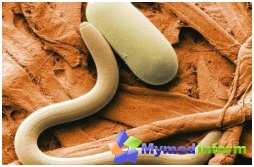Types of illness

Two types of atrophic rhinitis are distinguished:
- Primary atrophic rhinitis (or ozen). Characterized by the absence of alternative factors for the occurrence of the disease. Such rhinitis is caused by natural reasons that are not related to damaging impacts on the nasal cavity.
- Secondary atrophic rhinitis. Characterized by the effect of external factors for the nasal cavity, which lead to the disease. They can be: an unfavorable natural environment, for example, high dustiness, influence of chemicals. Often in the history of the disease atrophic rhinitis there are various surgical interventions in the nasal cavity.
Etiology atrophic rhinitis

The main symptoms that may indicate the possibility of atrophic rhinitis, are:
- feeling dryness in the nasal cavity;
- difficulty smell due to atrophing nerve endings;
- the formation of crusts on the mucous membrane of the nasal cavity;
- Small bleeding from the nasal cavity;
- Sensation of the nasal mucosa.
Diagnostic signs of the disease:
- During rhinoscopy, the mucous membrane has a pale pink color, with a dry and matte structure, with the presence of yellow-green crusts. This highlights a special refinement of the front share of the nasal partition.
- For the launched form of the disease, a malware smell of mucous discharge from the nose is characterized, which the patient itself may not feel because of the absence of smell.
Infectious atrophic rhinitis

Infectious atrophic rhinitis is a subspecies of this disease. The reasons for which it occurs more often is Sinegna sticks, such as Bordetella Bronchiseptica and Mycoplasma. Due to the impact of the pathogen in the nasal cavity begins the mucous-purulent inflammation of the mucous membrane. The result of such a process can be atrophy of the nasal shells and even the deformation of the bones of the skull.
Signs of this form of atrophic rhinitis can be gradually increasing runny nose, conjunctivitis. Wherein temperature The patient remains normal. As the disease progresses, patients become irritable, often shaking their heads, there is a decrease in appetite, a sharp weight loss. From visual symptoms, you can select the impaired symmetry of both jaws, softening and curvature of the nasal septum, silent bags under the eyes.
Atrophic rhinitis in children
The main reason for the occurrence of the disease is the abuse of vesseloring drops. Restless baby with nose nose Parents are trying to alleviate breathing with droplets. And indeed, such a technique helps, however, for a short time. The constant spasm of the vessels due to droplets violates the supply of the mucous membrane with blood, which leads to its atrophing. The danger of the disease in children is to reduce the flow of oxygen into the body, which can lead to the hypoxia of the brain and the delay in the development of the child.
Treatment of atrophic rhinitis

Treatment of atrophic rhinitis should be carried out under the strict observation of the otolaryngologist. Therefore, when identifying the symptoms of the disease, it is necessary to contact a specialist immediately. Deletion with adequate treatment may lead to severe consequences. Now on the Internet you can find hundreds of recipes, how to defeat atrophic rhinitis with the help of folk remedies. However, the readers of the MirSovet should consider that folk remedies can only be an addition to drug treatment. And again, they should be appointed only by a specialist. This is especially true of the infectious form of disease and severe atrophic rhinitis.
The main treatment for this pathology is local. Prescribe nasal drops on an oil-based basis. Treatment time should not exceed ten days. Since if you apply them longer, it can lead to an increase in edema and complication of the disease. In case of infectious atrophic reinforce Antibiotics Wide spectrum of action. Also do not forget about washing the nasal cavity with alkaline solutions. For this, as a rule, a sodium chloride solution is used with adding a few drops of iodine. The procedure must be repeated several times a day.
Prevention of atrophic rhinitis
The prevention of the disease is to exclude factors that can lead to it. The main techniques of the prevention of atrophic rhinitis are as follows:
- Nose cavity hygiene. The constant washing of the nose with weak alkaline solutions can significantly reduce the likelihood of the disease.
- Healthy way of life. Hiking fresh air, morning gymnastics can strengthen the body that reduces the likelihood of the disease.
- Healthy balanced nutrition can exclude such a cause of the disease, as a lack of vitamin D and iron.
- High hygiene. Household dust can be caused by the occurrence of the disease and drag it.









